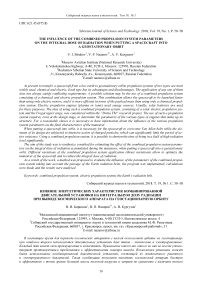The influence of the combined propulsion system parameters on the integral dose of radiation when putting a spacecraft into a geostationary orbit
Автор: Birukov V.I., Nazarov V.P., Kurguzov A.V.
Журнал: Сибирский аэрокосмический журнал @vestnik-sibsau
Рубрика: Авиационная и ракетно-космическая техника
Статья в выпуске: 1 т.19, 2018 года.
Бесплатный доступ
At present to transfer a spacecraft from a low earth to geostationary orbits propulsion systems of two types are most widely used: chemical and electric. Each type has its advantages and disadvantages. The application of any one of them does not always satisfy conflicting requirements. A possible solution may be the use of a combined propulsion system consisting of a chemical and electric propulsion system. This combination allows the spacecraft to be launched faster than using only electric motors, and it is more efficient in terms of the payload mass than using only a chemical propul- sion system. Electric propulsion engines (plasma or ionic) need energy sources. Usually, solar batteries are used for these purposes. The idea of using such a combined propulsion system, consisting of a solar electric propulsion sys- tem and the Fregat upper stage, was considered within the “Dvina TM” research project. The use of such a propulsion system requires, even at the design stage, to determine the parameters of the various types of engines that make up its structure. For a reasonable choice it is necessary to have information about the influence of the various propulsion system parameters on the final characteristics of the maneuver. When putting a spacecraft into orbit, it is necessary for the spacecraft to overcome Van Allen belts while the ele- ments of its design are subjected to intensive action of charged particles, which can significantly limit the period of ac- tive existence. Using a combined propulsion system, it is possible to shorten the time of being in a field of high radiation level significantly. The aim of the study was to synthesize a method for estimating the effect of the combined propulsion system parame- ters on the integral dose of radiation accumulated during the maneuver, when putting a spacecraft into a geostationary orbit. Different variations of the combined propulsion system application (thrust variations) allow to optimize the maneuver of the spacecraft and to reduce the integral dose of radiation. As a result of the work, a method was proposed to evaluate the influence of the parameters of the combined propul- sion system taking into account the passage of the Earth radiation belts, the program was implemented, calculations were made and the results were analyzed.
Ombined propulsion system, electric propulsion system, earth's radiation belt
Короткий адрес: https://sciup.org/148177801
IDR: 148177801 | УДК: 621.45
Текст научной статьи The influence of the combined propulsion system parameters on the integral dose of radiation when putting a spacecraft into a geostationary orbit
Introduction. The use of an electric propulsion system (EPS) for the transfer of a spacecraft (SC) from low earth orbit (LEO) to a geostationary orbit (GSO) makes it possible to increase the payload mass (P) delivered to the final transfer orbit in comparison with traditional chemical propulsion systems (CPS), due to more effective use of the working object mass [1; 2]. The reverse side of the EPS application is a long time of performing the orbital lift maneuver (the typical time of transition from LEO to GSO is 200 days), which leads to a general increase in the time required for putting into orbit, in particular, to an increase in time the SC spends in zones with an elevated level of radiation, the so-called Van Allen belts [3–5].
Fig. 1 shows the dependence of the radiation build-up on the thickness of the aluminum shield for a 200-day flight using EPS and the annual location of the SC on GSO. It can be seen that with a protection thickness of 4 mm, the SC radiation build-up of when putting into the GSO reaches 100 KRad, which is a critical level for electronic products manufactured by the most common technology for the production of KMOP electronic circuits [6–9]. For comparison, for a year of the SC location on a GSO with a similar protection, the radiation build-up is only 10 KRad.
Despite the advantages of using EPS from the point of view of P mass, EPS has initial drawbacks and it is necessary to find solutions that allow to overcome them. One of the possible solutions is the use of a combined propulsion system (CPS), which involves a combination of LPRE and EPS in an integrated system and the application of a particular engine to perform a certain phase of maneuver optimally.
For this purpose, it is necessary to determine the rational power characteristics of propulsion systems even at the design stage. To provide rationale for the choice of CPS design parameters, in this work, a study of the influence of various trajectory division variants of the entire trajectory into sections with the inclusion of various propulsion systems (PS) included in CPS was made.
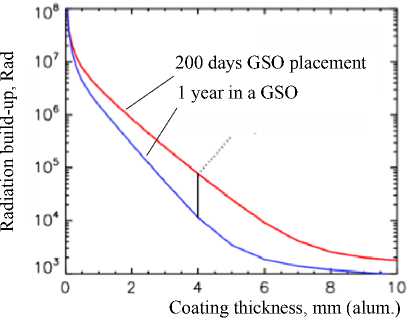
Fig. 1. Dependence of radiation build-up on the protective coating thickness
Рис. 1. Зависимость накопленной дозы радиации от толщины защитного покрытия
Existing software for assessing the effects of radiation on a satellite such as SHIELDOS, SPENVIS, STK SEET, allows to determine the final dose, accumulated by a spacecraft in a certain orbit, but some software is not entirely suitable for evaluating active maneuvers performed using engines of large and small thrust on a certain cyclogram, and the other is inaccessible [10]. Therefore, to carry out the research, it was required, based on existing ionizing radiation (IR) models, to write software adapted to perform the specific research tasks. A significant duration of the low-thrust engine flight requires for the performance of differential equations numerical integration used for various mathematical description phases of the general maneuver, substantial computing powers [11]. This solution required simplification of the existing models, optimization of the algorithms and computational methods, as well as the use of computers with high computational capabilities.
In the process of the research, a technique was developed to assess the spacecraft radiation build-up integral dose, a computer model was created and modeling was performed for a coplanar transition from LEO to GSO.
Formulation of the problem. The spacecraft equipped with EPS is located on LEO (200 km above the Earth). The spacecraft performs a coplanar maneuver of the transition to GSO in two phases. For creating thrust impulses in the first phase, the Fregat upper stage is used to carry out the transfer of the spacecraft from the initial orbit to the intermediate satellite orbit. Another block of several stationary plasma engines (type SPE 140) is used to transfer spacecraft from an intermediate orbit to an inclined geosynchronous orbit of the satellite and to carry out corrections, and then for subsequent transfer to a highly elliptical satellite orbit. Simultaneously, the electric propulsion system (EPS) creates moments of forces around the three axes to control the position of the apparatus relative to the center of mass and to unload the reaction wheel.
It is required to estimate the contribution of each phase to the total dose of SC devices radiation build-up.
Model. In works [1; 2] it was shown that the optimal maneuver of coplanar flight from the LEO to GSO using a pair of large and small thrust engines consists of 2 phases (fig. 2):
-
1. Gomanov flight with the use of high thrust engines.
-
2. Orbit raising of a spacecraft to the target highly elliptical orbit along the spiral trajectory by low-thrust engines.
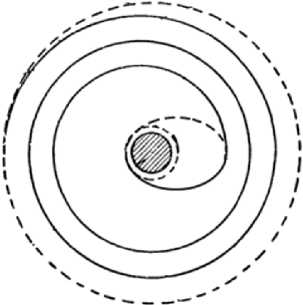
Fig. 2. The trajectory of the flight from LEO to GSO of the satellite using CPS
Рис. 2. Траектория перелета с НОО на ГСО ИСЗ с использованием КДУ
Knowing the initial mass of the spacecraft, the parameters of the propulsion system used in the CPS (thrust, specific impulse), the parameters of the initial and final orbits, one can enter a parameter k e (0-1), determining the position of the intermediate circular orbit to which the spacecraft is driven using the high-thrust engine in the Gomanov transition.
R2 = R + k (R3 - R), where R1 is the radius of LEO; R3 is the radius of GSO. R2 can be found analytically with high accuracy. By varying k parameter, one can determine the position of the intermediate orbit for each k value and construct a flight cyclogram using analytical dependencies to perform a Gomanov flight in the first phase of the maneuver and analytical dependencies for performing a long flight along a spiral trajectory using a low thruster in the second phase of the maneuver.
Depending on the parameters of the spacecraft, the initial and final orbits and k parameter, the spacecraft will move along different trajectories, passing through regions of space with different levels of ionizing radiation from outer space (IROS). Ionizing radiation includes the following types of radiation:
-
– Radiation from the Earth’s natural radiation belts (ENRB) (protons, electrons, α-particles, nuclei);
-
– Solar cosmic rays (SCR) (protons, electrons, α-particles);
-
– Solar wind (protons, electrons, α-particles);
-
– Galactic cosmic rays (GCR) (protons, electrons, α-particles, nuclei);
– Particles in the outer magnetosphere (protons, electrons, α-particles), albedo particles (protons, neutrons), NDO radiation from unclosed drift shells (protons, electrons), precipitating particles during magnetic disturbances (protons, electrons), etc.
The main danger in the spacecraft flight is the emission of ENRB, consisting of charged particles of different penetrating power, with energy from tens of kiV to hundreds of MeV for protons and tens of MeV for electrons which fluxes can reach a large value [12–15].
Galactic cosmic radiation is characterized by small fluxes (up to 5 particles × cm–2 × c–1) and high particle energies (up to 1020 eV).
Primary cosmic rays of galactic origin can be attributed to the sources of ENRB particles (high-energy protons arising from the decay of albedo neutrons formed by GCR particles upon interaction with atmospheric nuclei).
SCRs are formed during chromospheric flares on the Sun. Large fluxes of high-energy SCR particles can represent a radiation hazard for semiconductor ERI that are a part of spacecraft instrument units. The total dose of radiation obtained by the spacecraft throughout the maneuver can be received by integrating the individual doses obtained when the space vehicle is located at a specific point in space, the level of ionization radiation (IR) in which is known. To determine the level of IR, the model of IR distribution AR-8 was used [10].
To investigate the effect of phase distribution for the CPS engines on the integral dose received by the spacecraft during the maneuver, a mathematical model was constructed to solve the following main tasks: flight planning, iterative modeling, radiation assessment.
The numerical calculation algorithm for the model is shown in fig. 3 and consists of a series of sequential operations:
-
1. The parameters of the spacecraft and the parameters of the CPS engines are set.
-
2. The initial and final orbits are assigned, the distribution of the trajectory maneuver between phases 1 and 2.
-
3. The initial state vector (position, speed, acceleration) is set.
-
4. The scheduler performs calculations for the given parameters and builds a cyclogram of switching on the engines.
-
5. The solver performs the cyclogram step by step, determining the coordinates of the spacecraft at the next step, calculates and summarizes the value of the particle flux at a given point in space.
-
6. The output unit generates a flight path and an output data set corresponding to a given input data set.
The model of the radiation field. Mass distribution around SC blocks. Calculations of local radiation conditions inside the instrument unit take into account the weakening of the charged particles fluxes by different screening elements. The process of passing particles through matter can be represented by a random sequence of elementary events – their scattering, relaxation, generation, etc., in the intervals between which the particles move freely. The theory is not able to consider the fluctuations in particles energy losses correctly, their angular and energy distribution, and also the theoretical reliable description of the repeated radiation transfer. As a result, a number of approximate calculation methods have been created that are in satisfactory agreement with the experiment [12; 13; 15]. The main characteristics of charged particles deceleration in a substance are the specific losses
S(E) = — and particle range R(E) in a substance. The dx value of R(E) characterizes the braking capacity of the material, it is defined as the average energy lost by the particle per unit of path length. The total range is the path length of a particle with the initial energy Е0, which is braked to a full stop. The relationship of the ranges with energy losses in the material of the structure during brak-
E dE ing is described by the expression R(E) = J s(e)
. When
the particles are decelerated, various loss mechanisms in the material are known. Thus, at low energies, the main role is played by elastic scattering of the particles. For particles with energies E > 1 МэВ, the mechanisms of braking radiation are activated. Some contribution is made by Cherenkov radiation, transition radiation at medium boundaries, etc. The contribution of each mechanism to the total loss value depends on the particle energy, on the particle type and on the properties of the medium. According to the nature of the charged particles interaction with matter, they are usually divided into heavy (with mass М >> Ме) and light (М ~ Ме). Several computational models have been developed for determining local radiation conditions behind protective shells of various geometries (for example, hemispheres or halfplanes), depending on the material properties and the thickness of the shielding shells. The models are based on the definition of the “range-energy” ratio. Protons and heavier particles lose energy when passing through the protective shell due to the mechanism of ionization of atoms (ionization losses). In this case, the charged particle interacts with the valence electrons of the atom of the shell material. In this case, the energy of the proton Ех passing through a screen of thickness х in the direction of the particle motion with the initial energy Е can be determined as:
R ( E x ) = R ( E ) - x . (1)
This implies the condition for the boundary particles energy completely absorbed by the shielding screen. For particles with energy E > E мин , there is an equality of charged particles flows before and after protection
R ( E мин ) = X . (2)
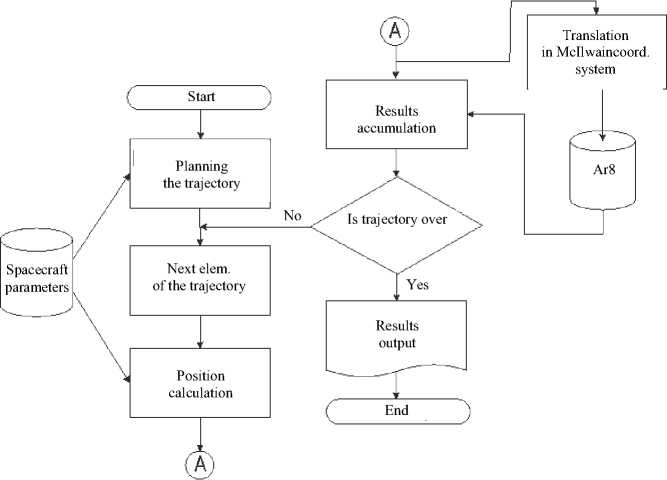
Fig. 3. Block diagram of the simulation algorithm
Рис. 3. Блок-схема алгоритма моделирования
Taking into account the specific losses, the spectrum can be expressed by the dependence
Ф x ( x ) = ф ( E )
S ( E )
S ( E x ) E = f ( Ex )
Here ф ( E ) - is the differential spectrum of the particles (protons) before the protection, calculated at the value of the energy E , and ф x ( E x ) - is after protection at the point corresponding to the argument Е х . In the arguments of the functions F ( E ) and S ( E ) energy values are expressed in terms of Ех .
Often, an empirical relationship is used between range and energy of the form [12; 13]
R ( E ) = a xEr (4)
for initial integral spectra of exponential types:
ф ( > E ) = 0 n [E ) , (5)
V E )
Ф ( > E ) = 0 e exp |- E |, (6)
V E н J
S ( E ) = —, dR
further, taking into account the connection between the energy losses and the particle ranges.
For the value of the differential spectra after protection, one can obtain:
Ф x ( E ) = n 0 n E H E n -1

0 f
Ф x ( E ) = -^ 1 1 +
En V
x
R ( E )
n
--I
r
exp
E | . x | r
— 1 +
E h V R ( E ) )
. (8)
In both formulas, the subscript х , indicating that this energy value refers to particles that have passed through the defense, is omitted.
To obtain the absorbed dose rate from a stream of charged particles that have passed through a shell of thickness – х , the integral is calculated
E 2
P x = J Ф x ( E ) S ( E ) dE , (9)
E 1
where Е 1 and Е 2 are the boundary energy values for which these energy absorption mechanisms are dominant.
For protons with energies Е р ≥ 103 MeV, the contribution to the dose due to ionization is small, therefore we take Е 2 = 103 MeV. The practice of calculating the multiple passage of charged particles through successive shields provides for calculating the function ф x ( E) of the differential spectrum, after each successive shell. Taking into account the approximate character of the calculations, in our case a one-time calculation was performed, but with the corresponding summation of the screen thicknesses. There are programs like GEAR 4 [16; 17] and others, which determine local radiation conditions, taking into account the geometry of the absorbing elements. We use assembly of shielding elements from simple sphere objects, cylinders, cones, etc. In our case we use a simplified statement of the problem – a screen in the form of a hemisphere made of aluminum. Fig. 4 shows the dependence of the proton range on its energy when using an aluminum screen. The thicknesses of the cases of the electronic equipment were not taken into account, as the absorption in the cases is carried into the reserve because of the approximate nature of the calculations. The ionization losses were calculated from the formulas (4)–(9) given above with the coefficients according to the data [12; 13]: for the protons a =1.73; r = 3.47 - 10-3; for a-particles a = 1.73, r = 3.1 - 10-4.
The radiation build-up received by the SC during the maneuvering time can be determined as the sum of the doses received from the location of the spacecraft in the field with some intensity during the interval
D = J P ( F ) dt , (10)
T where D - is the accumulated dose; P(r) - the intensity of radiation at the space point r = [ xy z ]r .
Calculation of the local absorbed doses (LAD) inside the SC units under consideration is carried out on the basis of mass distributions along the axes of the instrument blocks coordinates, protective devices and their thicknesses.
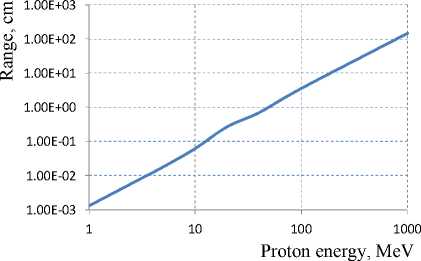
Fig. 4. Dependence of the proton range on its energy (material – aluminum)
Рис. 4. Зависимость пробега протона от его энергии (материал – алюминий)
Local absorbed doses are calculated by the formula:
ЛПД = - ■ £ Д , (11) 6 i = 1
where D i – is the value of the absorbed dose with a thickness of protection in i direction (there are only 6 of them along the coordinate axes).
The model of the Earth’s magnetic field. The Earth’s magnetic field is a dipole field whose axis is offset by about 11.4 degrees from the geographical axis. It is known that the intensities of the charged particles fluxes have a high spatial gradient. At low altitudes in the inner zone, a 3 % change in distance creates a 10-fold change in the intensity of the flow. Therefore, it is not possible to use the dipole model to determine the intensity of charged particles flows. It is necessary to use a coordinate system suitable for this task.
The most commonly used is the McIlwain coordinate system in which flows of charged particles having equal intensity are placed on surfaces that can be described in the coordinates L–B . Based on the experimental data collected during the launch of satellites studying the Earth’s magnetosphere, a spatial distribution of the intensities was obtained, which formed the basis of the AP 8 and AE 8 models for protons and electrons respectively [16].
The outer radiation belt consists mainly of electrons. A non-large-thickness protective shield protects the spacecraft from their effects effectively. Therefore, in the model only the inner radiation belt, consisting mainly of protons, is considered.
The flight dynamics of the spacecraft is modeled in a geocentric inertial coordinate system. To reduce the computational complexity, it is considered that the starting point of the maneuver coincides with the axis of the inertial GCS. The axis of the magnetic dipole rotates together with the rotation of the Earth. To calculate the IR level at the current point of space, the coordinates of the inertial GCS are transformed into dipole coordinates, after which the IR values are computed in accordance with the AR 8 model [17; 18].
The results of modeling. During modeling, the effect of the parameter k determining the ratio of the total maneuver share per phase realized by the Fregat US to the integral dose of radiation received by the spacecraft dur- ing the maneuvering time was studied. The parameter k varied in the range 0–1 in increments of 0.1.
A study of the dependence of the results on the integration step showed that step 1c is sufficient for the convergence of modeling results both in the period of high thrust provided by the Fregat US and during the long spiral transition to the EPS. At the chosen step, the simulation of the longest transition case (full transition to EPS) takes about 20 million steps. Computational complexity, illustrated in the graph (fig. 5), is significant even with the current level of computing facilities and required special measures to obtain results in finite time.
The graphs are given for a spacecraft having the following characteristics:
– initial weight of 3000 kg (CPS consists of LRE and EPS, usually LRE is accepted with low thrust);
-
– thrust 20 kH;
– specific impulse 3300 m/s.
The EPS has the following characteristics:
-
– thrust 0,7 H;
– specific impulse of 20,000 m/s.
The initial position of the spacecraft is a circular low Earth orbit with a height of 200 km with zero inclination. The final orbit is GSO.
For the various phase relations, the final characteristics and the transfer trajectory were obtained. An example of the obtained trajectory is shown in fig. 6.
Fig. 7 shows the calculated total radiation doses obtained in the delivery of a spacecraft with a different value of the parameter k . The analysis of the obtained data shows that the use of LRE at the initial stage of positioning phase allows to reduce the total level of the accumulated dose of radiation significantly. However, the use of LRE after passing the Van Allen radiation belts does not have a significant effect on the level of the accumulated radiation dose and its use does not give significant advantages to the dose effects in this sector. With a fully electrical transition, the accumulated dose for 200 days is 100 KRad. If the part of the trajectory with the working LRE is greater than 0.4 from the entire trajectory, the integral value of the accumulated dose varies insignificantly, so, in order to reduce the total dose of accumulated radiation, the use of LRE to perform more than 0.4 of the total transition is not rational.
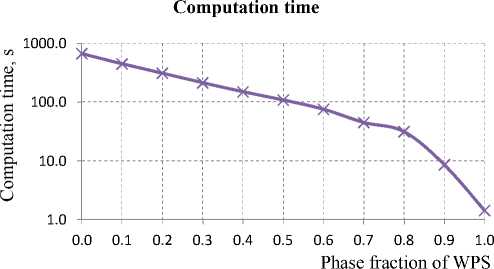
Fig. 5. Required computation time depending on the parameter k
Рис. 5. Требуемое время расчета в зависимости от параметра k
On the other hand, the influence of the working time of LRE as a fraction of the trajectory maneuver phase on the duration of the transition is shown in fig. 8. When using fully electric motors, the duration of the transition is 18 million sec or about 208 days. A balanced ratio between the duration of the transition and the radiation dose received can be selected at the expert level, depending on the mission being implemented and a number of nonformalized factors. The duration of the transition should be considered taking into account the dose effects in the spacecraft design and the choice of the energy characteristics of the engines included in the CPS.
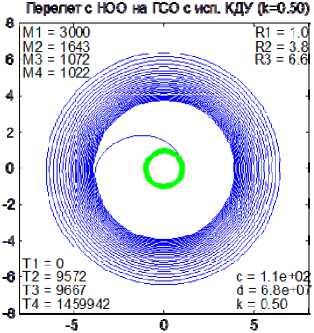
Fig. 6. The example of a trajectory
Рис. 6. Пример траектории

Integral accumulated radiation dose
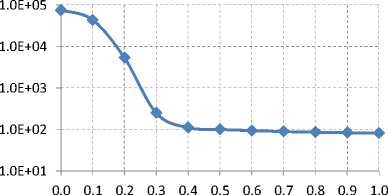
Phase fraction of WPS
Fig. 7. Diagram of integral accumulated radiation dose depending on the relative duration of the inclusion of CPS LRE
Рис. 7. График интегральной накопленной дозы радиации в зависимости от относительной длительности включения ЖРД КДУ
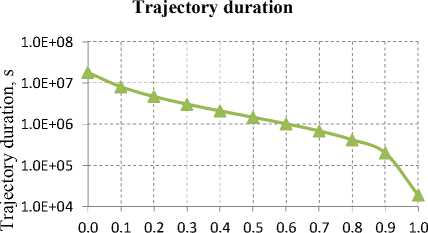
Phase fraction of WPS
Fig. 8. Duration of trajectory transition depending on the work phase fraction of the LRE
Рис. 8. Длительность траекторного перехода в зависимости от доли фазы работы ЖРД
Conclusion. The use of the CPS, consisting of large and small thrust engines, makes it possible to increase the efficiency of the raising the orbit maneuver from the LEO to the GSO. Efficiency should be understood as a complex indicator, some elements of which can be expressed in numerical form and used in making reasonable decisions at the design stage of CPS for a spacecraft. The calculation performed allows to estimate the influence of the chosen ratio proportion of the maneuver part between different types of engines on the integral dose of radiation received by the spacecraft during the whole maneuver. The rationale for the combination of various propulsion systems in the CPS at the design stage requires an assessment of selection consequences of the CPS parameters for the final characteristics of putting the spacecraft to the target orbit. During the research, a technique was proposed to evaluate the influence of such a choice on the integral dose of radiation received by the spacecraft during the time of transition. The results of the study provide an opportunity for a reasonable decision on the relationship of energy characteristics between the LRE and EPS in the CPS in terms of accumulated radiation dose and the total time of the task. Simulation was carried out for the transition maneuver from LEO on GSO, which is the most widespread and most interesting for optimization. To determine the influence of other factors and different scenarios on the effectiveness of CPS application, further work on modeling and computational research is necessary.
Список литературы The influence of the combined propulsion system parameters on the integral dose of radiation when putting a spacecraft into a geostationary orbit
- Гильзин К. А. Электрические межпланетные корабли. 2-е изд. перераб. и доп. М.: Наука, 1970. 267 с.
- Механика космического полета: учебник для втузов/М. С. Константинов ; под ред. В. П. Ми-шина. М.: Машиностроение, 1989. 348 с.
- McIlwain C. E. Coordinates for Mapping the Distribution of Magnetically Trapped Particles//Jour. Geophysical Res. 1961, № 66. Pp. 3681-3691.
- Runcorn S. K. The Magnetism of the Earth’s Body//Geophysik I: Handbuch der Physik XLVII Springer, 1956. Pp. 498-533.
- Observation of High Intensity Radiation by Satellites 1958 Alpha and Gamma/J. A. Van Allen //Jet Propulsion. 1958, № 28. Pp. 588-592.
- Мак Илуэйн К. Е. Координаты для отображения распределения частиц, захваченных геомагнитным полем//Операция «Морская звезда»: сб. статей/под ред. И. А. Жулина. М.: Атомиздат, 1964. С. 98-103.
- Barth J. Applying modeling space radiation environments//IEEE Nuclear and Space Radiation Effects. Short Course. Applying Computer Simulation Tools to Radiation Effects Problems/Snowmass Conference Center. Snowmass Village, Colorado, 1997. Р. 354-367.
- The Radiation Design Handbook/European Space Agency. Noordwijk, the Nederland: ESTEC. 1993. 444 p.
- Fox N., Burch J. L. The Van allen probes mission. Springer, 2013. Р. 294.
- NASA SP-3024. Models of the trapped radiation environment. Vol. I: Inner Zone/National AERONAU-TICS AND SPACE ADMINISTRATION. Washington, D.C., 1966. Р. 178.
- Lew J. S. Drift Rate in a Dipole Field//Jour. Geophysical Res. 1961. № 66. Pp. 2681-2686.
- Гегелев И. В., Зубарев А. И., Пудовкин О. Л. Радиационная обстановка на борту космических аппаратов//РВСН, ЦИПК. 2001. № 77. 316 с.
- Бирюков В. И., Бирюкова М. В. Алгоритм прогнозирования радиационного воздействия на аппаратуру микроспутника.//Вестник МАИ. 2013. Т. 20, № 3. С. 40-49.
- Методы испытаний и оценки стойкости бортовой радиоэлектронной аппаратуры космических аппаратов к воздействию электронных и протонных излучений космического пространства по дозовым эффектам: ОСТ 134-1034-2003.
- Модель космоса. Т. 2. Воздействие космической среды на материалы и оборудование космических аппаратов. М.: МГУ НИИЯФ, 2007. С. 317.
- Безопасность радиационная экипажа космического аппарата в космическом полете. Характеристики ядерного взаимодействия протонов: ГОСТ 25645.211-85.
- Козлов А. А., Чумаков А. И. Алгоритм оценки конструкционной защиты космических аппаратов//Стойкость-2004: науч.-техн. сб. 2004. Вып. 7. С. 21-22.
- Радиационная стойкость. Методы расчета: ГОСТ РВ 20.57.308-98.

